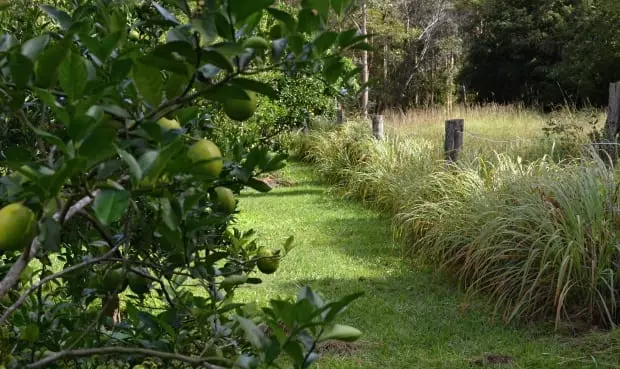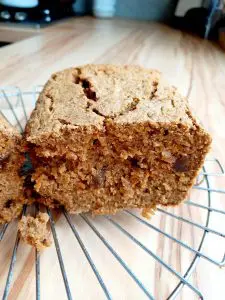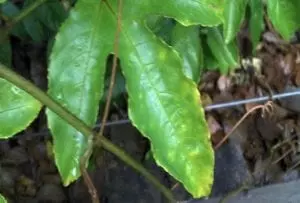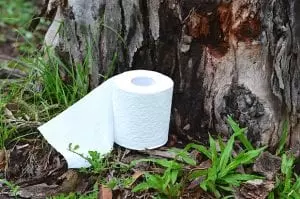Lemongrass is one of those famous herbs known the world over for flavouring Asian food. It's considered quite exotic but I really don't understand why because there isn't anything mysterious about the plant at all in my humble opinion. The fact is, lemongrass is terribly easy to grow and most likely why it became so widely used in food all around the world particularly in Asian cuisine.
And, it's so easy to grow that I don't just grow lemongrass for its magnificent flavour – not at all, I grow lemongrass because it looks great in the garden as an ornamental and it acts as a weed deterrent down my property fence lines. That's right, I grow lemongrass along my fence to suppress weeds and other grasses from growing and that means I don't have to use a herbicide to control weeds and grass. See our video on lemongrass.

Lemongrass growing down my fenceline is handy in more ways than one (image above)
But that's not all, in winter I cut my lemongrass back – give it a good trim, because it encourages better growth in the spring. I use the clippings in my garden as a highly nutritious, nitrogen rich, plant food mulch.
Therefore, lemongrass serves me four ways: as food, eye candy, weed controller, and a fertiliser mulch. This is why I rave about lemongrass so much because without this wonderful plant, my garden and diet would be mourning the loss.
Where does it grow?
Lemongrass is a warm climate plant but it can grow quite well in cold climates so my advice would be to give it a go for sure! In cold climates, try and grow it in a sunny protected area or against a sunny wall. Of course, growing lemongrass in a greenhouse is a top idea as it doesn't take up much space (if you keep it trimmed) and it'll grow well in pots.
For everywhere else, lemongrass can be planted anywhere and due to its clumping nature it won't “get away” in the garden and tends to just grow outwards and thicker rather than spreading. Having said that, it will grow fast through a nice warm summer with plenty of water so it certainly isn't a slow grower.
Soil – Free draining soil is best but it will withstand heavier ground.
Propagation
Lemongrass is a grass (believe it or not) and as such grows the same as any other clumping grass variety. It can be grown from seed; however, lemongrass is much easier to grow via a division by digging or pulling out a stem with some root and replanting. Dividing lemongrass can be done at any time of the year; although, it's probably best done at the start of spring and the growing season.
If the division has a long stem then cutting off half and leaving about 30cm of grass stem will aid against water loss and help create new growth ensuring it gets a good start in its new spot. Give the new plant plenty of water and you'll find it will be thriving in no time.
One stem of lemongrass should grow into a nice big clump in about 12 months when it can be divided (or just a few stems pulled) again to produce more plants.

Lemongrass division roughly dug-in will grow fast into a large clump in no time (image above)
When to plant?
Best growing times and conditions differ around the world due to general climatic conditions and also your own garden micro-climate/s. Lemon grass generally does best as the weather warms up and its growing period is through spring/summer so planting it during this time is a good idea but not essential.
Pests and disease
You needn't worry too much about this plant as it seems resistant to most pest and disease. Lemongrass can get the odd rust in its leaves and some occasional die off; but honestly, leave it fend for itself and it should thrive.
Is lemongrass good for you?
Crikey yes! Lemongrass is very high in iron and a good source of natural folate and of course it doesn't have any fat or cholesterol. Just looking at lemongrass can make you lose weight… just kidding about the weight loss through admiration; but, eating lemongrass through traditional recipes could have beneficial weight loss consequences due to its healthy nature.
Preparing and eating lemongrass 
Lemongrass has a unique flavour (yes it's lemon-ish) still, I wouldn't describe it as bitter or sour lemon. The aroma, as much as anything, excites the taste buds and its flavour adds its own special tang to a dish.
Harvesting lemongrass is simple – grab the stem about halfway down and yank it out of its clumpy crown. Then, cut the top of the grass stem off about 10 inches from the base and if using immediately cut off the woody root. You should be left with 9 or 10 inches of cut lemongrass stem all of which can be chopped finely and eaten. Nevertheless, the best part is the core of the stem between the base and about 10cm up the stem. This piece (as thick as a pencil) is the most tender and tastiest part of the plant so if you do have lots of lemongrass (like me) use a few stalks for a meal and take the best bits.
In cooking, lemongrass can be finely chopped and added to a recipe (say a stir-fry) or the stalk can be bruised and thrown in whole for a hint of flavour (like a soup or broth for instance).
Recipe – Thai inspired lemongrass roasted chicken wings

Yes, I made this recipe up; nevertheless, it has probably been done by millions of people before me. When you're cooking with fresh ingredients mostly sourced from your backyard it isn't difficult to make a good meal because the food is good from the beginning.
Ingredients
1kg, or so, of chicken wings (free-range if you can)
1 x stalk of lemongrass
4 chillies (hot or mild depending on your taste)
Chopped garlic (about a tablespoon)
½ cup grated ginger
The juice of 4 limes
1 x tablespoon of cornflour (mixed with ⅓ cup water)
⅓ cup of sugar
⅓ cup of fish sauce
½ cup of finely chopped coriander stems (as a garnish)
Sprinkle of salt for seasoning
Method
Step 1 – In a mixing or marinating bowl/container, combine the lime juice, cornflour mixed with water, sugar, and fish sauce. Stir and mix to dissolve the sugar as good as possible.

Step 2 – Finely chop and mix together the lemongrass, chillies, garlic, and ginger. Then add and mix to the above marinate.

Step 3 – Add the chicken wings to the marinate and massage the marinate mix to ensure all the chicken has touched and infused with the mix. Leave to rest in the fridge for a few hours or overnight.

Step 4 – Place the chicken one layer only in an oven pan, along with all the marinate. Cook in a pre-heated oven on 180°C for about 45 minutes or until cooked through and golden brown. The marinate sauce should be thick and glossy.

Step 5 – Remove the chicken and place in a serving bowl/plate then pour the reduced marinate sauce over the chicken. Top with a sprinkling of the chopped coriander stems. Serve with rice or steamed vegetables.

Conclusion
Lemongrass is such a versatile plant and now you have several reasons for why you must have it in your garden.
Even if you just grow lemongrass as an ornamental for looks and for aroma when you brush past the plant as you stroll in the garden, it's still worth growing. However, once it has established itself in a garden it's extremely hard not to use it in cooking because lemongrass fresh from the garden can turn your cooking from homely to gourmet Asian with little effort at all.
If you would like to comment on this article you can do so below (email is not required) or join our forum Self Sufficient Culture and strike up a conversation. Also, you can watch our video on lemongrass.
Thanks for reading and thanks for your support.
Mark Valencia Editor SSM
Look, and see the Earth through her eyes…













